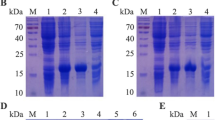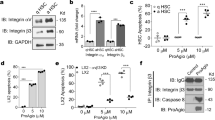Abstract
Liver fibrosis usually progresses to liver cirrhosis and even hepatocellular carcinoma. Since activated hepatic stellate cells (aHSCs) are responsible for liver fibrosis, reducing the quantity of aHSCs was considered the essential strategy for clinical antihepatofibrotic therapy. Due to the overexpression of TRAIL receptor 2 (DR5) in aHSCs, human TNF-related apoptosis-inducing ligand (hTRAIL) that could induce aHSCs apoptosis might be feasible for antihepatofibrotic therapy. However, the in vivo aHSCs-apoptosis-induction of hTRAIL is limited by its poor cell-targeting and a short half-life. In this study, we found that platelet-derived growth factor receptor β (PDGFRβ) was co-expressed with DR5 in aHSCs. And the ZPDGFRβ affibody with high affinity for PDGFRβ could bind aHSCs and, thus, accumulate in the fibrotic liver. ZPDGFRβ was fused to hTRAIL to produce the fusion protein Z-hTRAIL. Compared to hTRAIL, Z-hTRAIL showed greater in vitro cell binding and apoptosis-induction in aHSCs. In addition, Z-hTRAIL induced apoptosis of aHSCs but spared other normal liver cells. In vivo, Z-hTRAIL accumulated preferentially in fibrotic livers and exerted greater effects than hTRAIL in inducing aHSCs apoptosis and reducing extracellular matrix (ECM) deposition. These results demonstrated that the antihepatofibrotic effect of hTRAIL was improved by PDGFRβ-targeted delivery. To enhance its pharmacokinetics, Z-hTRAIL was modified with 10 kDa polyethylene glycol (PEG), which significantly (30–40 times) prolonged its half-life. The PEGylated long-acting Z-hTRAIL was more potent than the native Z-hTRAIL in regressing liver fibrosis. These results suggest that the aHSC-targeting and long-acting Z-hTRAIL might serve as a novel tool for antihepatofibrotic therapy.







Similar content being viewed by others
References
Zhang CY, Yuan WG, He P, Lei JH, Wang CX (2016) Liver fibrosis and hepatic stellate cells: etiology, pathological hallmarks and therapeutic targets. World J Gastroenterol 22(48):10512–10522
Jiang JX, Torok NJ (2013) Liver injury and the activation of the hepatic myofibroblasts. Curr Pathobiol Rep 1(3):215–223
Mokdad AA, Lopez AD, Shahraz S, Lozano R, Mokdad AH, Stanaway J, Murray CJ, Naghavi M (2014) Liver cirrhosis mortality in 187 countries between 1980 and 2010: a systematic analysis. BMC Med 12:145
Wang FS, Fan JG, Zhang Z, Gao B, Wang HY (2014) The global burden of liver disease: the major impact of China. Hepatology 60(6):2099–2108
Weiskirchen R, Tacke F (2016) Liver fibrosis: from pathogenesis to novel therapies. Dig Dis 34(4):410–422
Higashi T, Friedman SL, Hoshida Y (2017) Hepatic stellate cells as key target in liver fibrosis. Adv Drug Deliv Rev 121:27–42
Pellicoro A, Ramachandran P, Iredale JP, Fallowfield JA (2014) Liver fibrosis and repair: immune regulation of wound healing in a solid organ. Nat Rev Immunol 14(3):181–194
Ebrahimi H, Naderian M, Sohrabpour AA (2018) New concepts on reversibility and targeting of liver fibrosis; a review article. Middle East J Dig Dis 10(3):133–148
Schon HT, Bartneck M, Borkham-Kamphorst E, Nattermann J, Lammers T, Tacke F, Weiskirchen R (2016) Pharmacological intervention in hepatic stellate cell activation and hepatic fibrosis. Front Pharmacol 7:33
Yuan X, Gajan A, Chu Q, Xiong H, Wu K, Wu GS (2018) Developing TRAIL/TRAIL death receptor-based cancer therapies. Cancer Metastasis Rev 37(4):733–748
Soria JC, Mark Z, Zatloukal P, Szima B, Albert I, Juhasz E, Pujol JL, Kozielski J, Baker N, Smethurst D, Hei YJ, Ashkenazi A, Stern H, Amler L, Pan Y, Blackhall F (2011) Randomized phase II study of dulanermin in combination with paclitaxel, carboplatin, and bevacizumab in advanced non-small-cell lung cancer. J Clin Oncol 29(33):4442–4451
Taimr P, Higuchi H, Kocova E, Rippe RA, Friedman S, Gores GJ (2003) Activated stellate cells express the TRAIL receptor-2/death receptor-5 and undergo TRAIL-mediated apoptosis. Hepatology 37(1):87–95
Fasbender F, Widera A, Hengstler JG, Watzl C (2016) Natural killer cells and liver fibrosis. Front Immunol 7:19
Radaeva S, Sun R, Jaruga B, Nguyen VT, Tian Z, Gao B (2006) Natural killer cells ameliorate liver fibrosis by killing activated stellate cells in NKG2D-dependent and tumor necrosis factor-related apoptosis-inducing ligand-dependent manners. Gastroenterology 130(2):435–452
Glässner A, Eisenhardt M, Krämer B, Körner C, Coenen M, Sauerbruch T, Spengler U, Nattermann J (2012) NK cells from HCV-infected patients effectively induce apoptosis of activated primary human hepatic stellate cells in a TRAIL-, FasL- and NKG2D-dependent manner. Lab Invest 92(7):967–977
Wijaya RS, Read SA, Schibeci S, Eslam M, Azardaryany MK, El-Khobar K, van der Poorten D, Lin R, Yuen L, Lam V, George J, Douglas MW, Ahlenstiel G (2019) KLRG1 + natural killer cells exert a novel anti-fibrotic function in chronic hepatitis B. J Hepatol 71(2):252–264
Yang JA, Kong WH, Sung DK, Kim H, Kim TH, Lee KC, Hahn SK (2015) Hyaluronic acid-tumor necrosis factor-related apoptosis-inducing ligand conjugate for targeted treatment of liver fibrosis. Acta Biomater 12:174–182
Oh Y, Park O, Swierczewska M, Hamilton JP, Park JS, Kim TH, Lim SM, Eom H, Jo DJ, Lee C, Kechrid R, Mastorakos P, Zhang C, Hahn SK, Jeon O, Byun Y, Kim K, Hanes J, Lee KC, Pomper MG, Gao B, Lee S (2016) Systemic PEGylated TRAIL treatment ameliorates liver cirrhosis in rats by eliminating activated hepatic stellate cells. Hepatology 64(1):209–223
Li Q, Ding Y, Guo X, Luo S, Zhuang H, Zhou J, Xu N, Yan Z (2019) Chemically modified liposomes carrying TRAIL target activated hepatic stellate cells and ameliorate hepatic fibrosis in vitro and in vivo. J Cell Mol Med 23(3):1951–1962
Li D, He L, Guo H, Chen H, Shan H (2015) Targeting activated hepatic stellate cells (aHSCs) for liver fibrosis imaging. EJNMMI Res 5(1):71
Dobie R, Henderson NC (2016) Homing in on the hepatic scar: recent advances in cell-specific targeting of liver fibrosis. F1000Res 5:1749
van Dijk F, Olinga P, Poelstra K, Beljaars L (2015) Targeted therapies in liver fibrosis: combining the best parts of platelet-derived growth factor BB and interferon gamma. Front Med 2:72
Marr A, Nissen F, Maisch D, Altmann A, Rana S, Debus J, Huber PE, Haberkorn U, Askoxylakis V (2013) Peptide arrays for development of PDGFRbeta Affine molecules. Mol Imaging Biol 15(4):391–400
Lindborg M, Cortez E, Hoiden-Guthenberg I, Gunneriusson E, von Hage E, Syud F, Morrison M, Abrahmsen L, Herne N, Pietras K, Frejd FY (2011) Engineered high-affinity affibody molecules targeting platelet-derived growth factor receptor beta in vivo. J Mol Biol 407(2):298–315
Tao Z, Yang H, Shi Q, Fan Q, Wan L, Lu X (2017) Targeted delivery to tumor-associated pericytes via an affibody with high affinity for PDGFRbeta enhances the in vivo antitumor effects of human TRAIL. Theranostics 7(8):2261–2276
Bottcher K, Pinzani M (2017) Pathophysiology of liver fibrosis and the methodological barriers to the development of anti-fibrogenic agents. Adv Drug Deliv Rev 121:3–8
Nie Q, Jia D, Yang H, Feng Y, Fan Q, Shi Q, Wan L, Lu X (2017) Conjugation to 10 kDa linear PEG extends serum half-life and preserves the receptor-binding ability of mmTRAIL with minimal stimulation of PEG-specific antibodies. Mol Pharm 14(2):502–512
Shi YF, Fong CC, Zhang Q, Cheung PY, Tzang CH, Wu RS, Yang M (2007) Hypoxia induces the activation of human hepatic stellate cells LX-2 through TGF-beta signaling pathway. FEBS Lett 581(2):203–210
Luli S, Di Paolo D, Perri P, Brignole C, Hill SJ, Brown H, Leslie J, Marshall HL, Wright MC, Mann DA, Ponzoni M, Oakley F (2016) A new fluorescence-based optical imaging method to non-invasively monitor hepatic myofibroblasts in vivo. J Hepatol 65(1):75–83
Ishak K, Baptista A, Bianchi L, Callea F, Groote J, Gudat F, Denk H, Desmet V, Korb G, MacSween RNM, Phillips MJ, Portmann BJ, Poulsen H, Schmid PJSM, Thaler H (1995) Histological grading and staging of chronic hepatitis. J Hepatol 22(6):696–699
de Oliveira da Silva B, Ramos LF, Moraes KCM (2017) Molecular interplays in hepatic stellate cells: apoptosis, senescence, and phenotype reversion as cellular connections that modulate liver fibrosis. Cell Biol Int 41(9):946–959
Trautwein C, Friedman SL, Schuppan D, Pinzani M (2015) Hepatic fibrosis: concept to treatment. J Hepatol 62(1 Suppl):S15–S24
Wajant H, Gerspach J, Pfizenmaier K (2013) Engineering death receptor ligands for cancer therapy. Cancer Lett 332(2):163–174
La OR, Tai L, Lee L, Kruse EA, Grabow S, Fairlie WD, Haynes NM, Tarlinton DM, Zhang JG, Belz GT, Smyth MJ, Bouillet P, Robb L, Strasser A (2009) Membrane-bound Fas ligand only is essential for Fas-induced apoptosis. Nature 461(7264):659–663
Gerspach J, Pfizenmaier K, Wajant H (2009) Improving TNF as a cancer therapeutic: tailor-made TNF fusion proteins with conserved antitumor activity and reduced systemic side effects. BioFactors 35(4):364–372
Vazquez-Lombardi R, Phan TG, Zimmermann C, Lowe D, Jermutus L, Christ D (2015) Challenges and opportunities for non-antibody scaffold drugs. Drug Discov Today 20(10):1271–1283
Stahl S, Graslund T, Eriksson Karlstrom A, Frejd FY, Nygren PA, Lofblom J (2017) Affibody molecules in biotechnological and medical applications. Trends Biotechnol 35(8):691–712
Malhi H, Barreyro FJ, Isomoto H, Bronk SF, Gores GJ (2007) Free fatty acids sensitise hepatocytes to TRAIL mediated cytotoxicity. Gut 56(8):1124–1131
Klinkhammer BM, Floege J, Boor P (2018) PDGF in organ fibrosis. Mol Asp Med 62:44–62
Akram K, Lomas NJ, Forsyth NR, Spiteri MA (2014) Alveolar epithelial cells in idiopathic pulmonary fibrosis display upregulation of TRAIL, DR4 and DR5 expression with simultaneous preferential over-expression of pro-apoptotic marker p53. Int J Clin Exp Pathol 7(2):552–564
Park JS, Oh Y, Park YJ, Park O, Yang H, Slania S, Hummers LK, Shah AA, An HT, Jang J, Horton MR, Shin J, Dietz HC, Song E, Na DH, Park EJ, Kim K, Lee KC, Roschke VV, Hanes J, Pomper MG, Lee S (2019) Targeting of dermal myofibroblasts through death receptor 5 arrests fibrosis in mouse models of scleroderma. Nat Commun 10(1):1128
Acknowledgements
This study was funded by the National Natural Science Fund of China (81273419, 81573336, LXF) and “1.3.5 project for disciplines of excellence, West China Hospital, Sichuan University” (ZYGD18014, CJQ).
Author information
Authors and Affiliations
Corresponding authors
Ethics declarations
Conflict of interest
The authors declare that they have no conflict of interest.
Ethical approval
All applicable institutional guidelines for the care and use of animals were followed.
Additional information
Publisher's Note
Springer Nature remains neutral with regard to jurisdictional claims in published maps and institutional affiliations.
Electronic supplementary material
Below is the link to the electronic supplementary material.
Rights and permissions
About this article
Cite this article
Li, R., Li, Z., Feng, Y. et al. PDGFRβ-targeted TRAIL specifically induces apoptosis of activated hepatic stellate cells and ameliorates liver fibrosis. Apoptosis 25, 105–119 (2020). https://doi.org/10.1007/s10495-019-01583-3
Published:
Issue Date:
DOI: https://doi.org/10.1007/s10495-019-01583-3




